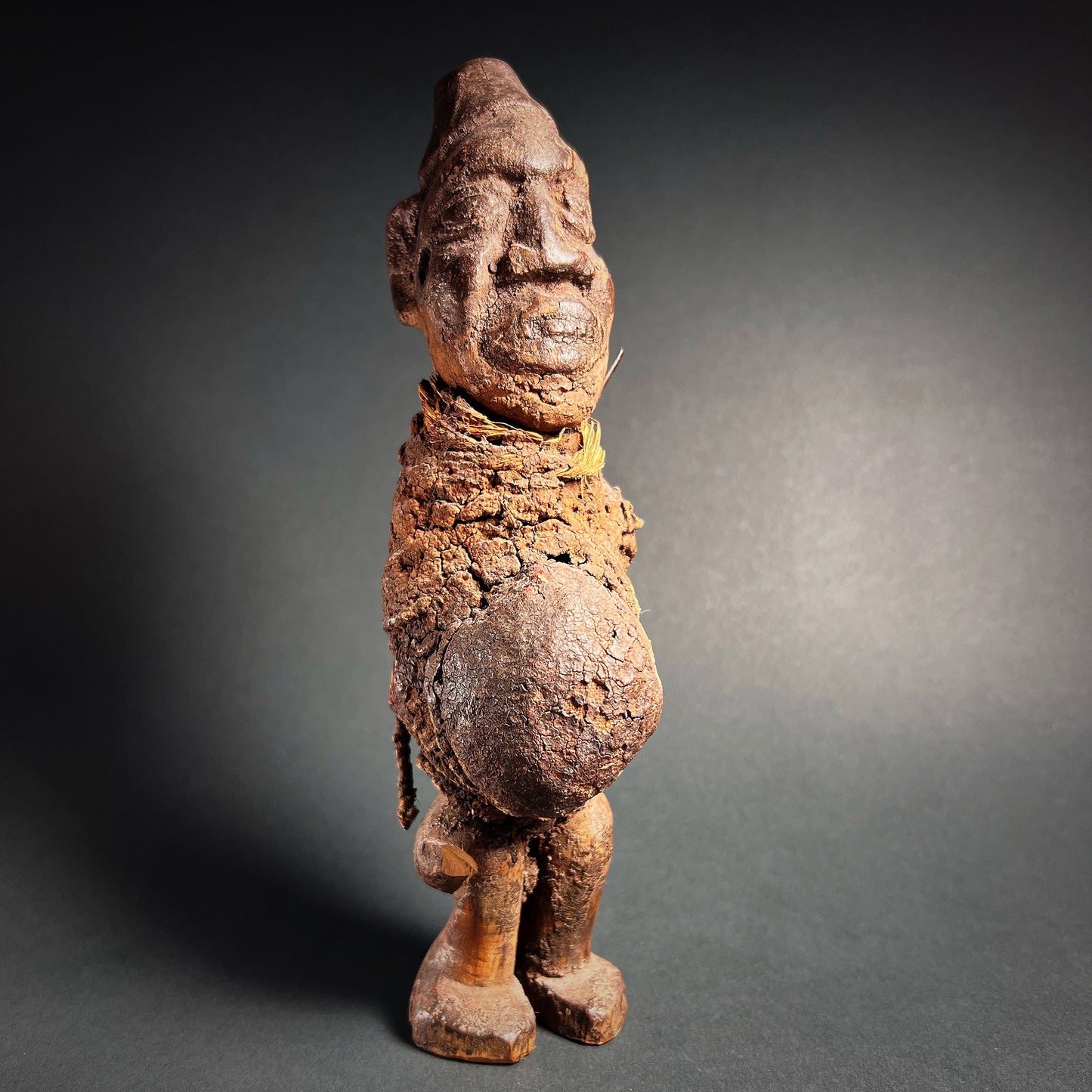Teke Fetish Male Figure (Buti)
Teke Fetish Male Figure (Buti)
Couldn't load pickup availability
Teke people, mid-20th century, Republic of the Congo, Central Africa
Magnificent small-sized Teke fetish male figure (buti), representing a revered ancestor and believed to embody the ancestor’s substance (ikwii). Carved in the classical Teke style, the figure features a large head, rectangular torso, and slightly bent legs with robust feet. The face is that of an elder, with almond-shaped eyes, a wide flat nose, crescent-shaped ears, an open mouth, and a characteristic cap-like headdress.
At the front of the figure sits the powerful fetish bundle, encased in a membrane and coated with clay, resin, red tukula powder, and tightly bound with cord and rattan—materials that reinforce the object’s spiritual charge.
Individually owned (in contrast to larger communal fetishes), buti figures were used for protection against witchcraft, healing illness, acquiring influence, and directing vengeance. Their effectiveness derives from the bonga or bilongo, a magical assemblage inserted into the cavity or wrapped around the body. This could include whitish clay (mpieme, symbolizing ancestral bones), nail clippings or hair of a venerated person, leaves of potent plants, and parts of snakes or leopards. Each figure had a specific purpose known only to its owner. If a fetish proved exceptionally powerful, fragments of its bonga might be redistributed to create new figures, leaving the original weakened and “bloodless.” Figures retaining their charge are called buti; those without it are tege, inert and without force.
The Teke (or Bateke), a Bantu-speaking people living across the savannah high plateau spanning the Republic of the Congo, the Democratic Republic of the Congo, and Gabon, maintain a cosmology that includes an invisible parallel world ruled by the creator Nziam. Ancestor veneration and the appeasement of nature spirits formed the core of Teke ritual life—context that gives this figure its profound cultural and spiritual resonance.
A superb, authentic example of Teke ritual art, rich in materiality, presence, and ancestral power.
Excellent condition. Layered and encrusted surface patina suggesting genuine age and ritual use. Traces of libation. Size approx. 19,5cm x 5,3cm x 5,9cm.
Provenance: From the estate of Swedish painter and pop artist Sven Inge Höglund (1935–2008). Foundation for Innovative Art.
References and further reading:
Teke Fetishes, Robert Hottot & Frank Willett, The Journal of the Royal Anthropological Institute of Great Britain and Ireland 86, no. 1, 1956, pp. 25-36. (https://doi.org/10.2307/2844049)
The Tribal Arts of Africa, Jean-Baptiste Bacquart, Thames & Hudson, 2002.





-
Shipping
The shipment will be prepared in the course of 3-5 days and dispatched via Posti Group Oyj or purchased item(s) can be picked up from our shop during the store's opening hours (Tarkk’ampujankatu 4, 00140, Helsinki, Finland). Within the Finland, all items are shipped via Posti Group Oyj unless otherwise requested. We pack the items carefully and mainly in recycled materials because we want to save nature. You will receive the tracking number for your items by e-mail.
-
Returns
Returns and exchange will be accepted within fourteen days (14) of receipt at the purchaser’s cost to include freight and packaging. Items must be returned in the same condition as when they were shipped, and will not be accepted if damaged or altered in any way. Please inform us via email (info@gotanmaailma.fi) or by calling +358408408352 before sending. We do not accept returns more than 14 days after delivery.





